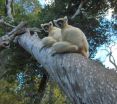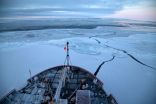Family ties: Social structure matters in species conservation
2015-06-15
(Press-News.org) This news release is available in Portuguese.
Many animal species, including humans, live and breed in groups with complex social organizations. The impact of this social structure on the genetic diversity of animals has been a source of disagreement between scientists. In a new study now published in the latest edition of the scientific journal PNAS*, Barbara Parreira and Lounes Chikhi from Instituto Gulbenkian de Ciencia (IGC; Portugal) show that social structure is important to maintain the genetic diversity within species. The researchers provide a new mathematical model that can be used by population geneticists and ecologists to better predict how social groups will influence the way species maintain genetic diversity and evolve, and ultimately help in the conservation of species.
Like families, where individuals of different gender, age and dominance live together, several groups of insects, birds and mammals form a well-defined social structure. Being part of a group can be extremely beneficial to animals as a way to obtain food, defend themselves from predators or cope with environmental changes. But it can also bring disadvantages, such as an increased risk of catching diseases or parasites. Geneticists usually consider that due to the small size of social groups, these are at high risk of losing diversity and becoming inbred. However, these predictions are not always consistent with the field observations carried out by ecologists, who found high-diversified groups. So what is the role of these "families" in terms of genetic diversity?
The study conducted by Barbara Parreira and Lounes Chikhi now reconciles these two fields. The research team developed a model with well-defined parameters, and included information about social structure. By using genetic and ecological data, the researchers simulated populations, with different mating strategies. Their results show that social structure is highly efficient in maintaining diversity within individuals in social groups. The researchers believe this model better reflects the complexities of social species - in comparison to other models that do not consider the social organization of populations - and thus allows field biologist to test specific predictions about the effects of sociality.
Lounes Chikhi, who is also a Senior Researcher at the French CNRS, says: "Population geneticists tend to use simple models to represent the complexity of real species. For some questions this is probably the best solution. We need simple and general models with few parameters. However, when one wants to understand what is happening in the field, we also need models that are more easily related to the real world. The work done by Barbara is important, as it provides a framework and a simulation tool that many ecologists and conservation biologists will be able to use."
Barbara Parreira, a PhD candidate of Lounes Chikhi's laboratory, adds: "With this framework we show that social groups, despite being small groups of related individuals, are extremely effective in maintaining diversity. It is actually within these groups that the genetic diversity of a whole population is primarily preserved. Maintaining them is probably one of the most important things when conserving a species."
INFORMATION:
This study was carried out at Instituto Gulbenkian de Ciencia (Oeiras, Portugal), funded by Fundacao para a Ciencia e a Tecnologia (Portugal), LabEx TULIP (France) and LIA BEEG-B (CNRS, France).
* Parreira B, Chikhi L (2015) On some genetic consequences of social structure, mating systems, dispersal, and sampling. PNAS Article #14-14463. doi: 10.1073/pnas.1414463112.
[Attachments] See images for this press release:

ELSE PRESS RELEASES FROM THIS DATE:
2015-06-15
Belonging to multiple groups that are important to you boosts self-esteem much more than having friends alone, new research has found.
CIFAR fellows Nyla Branscombe (University of Kansas), Alexander Haslam and Catherine Haslam (both University of Queensland) recently collaborated with lead author Jolanda Jetten on experiments to explore the importance of group memberships for self-esteem. Working with groups of school children, the elderly, and former homeless people in the United Kingdom, China and Australia, their studies showed consistently that people who belong ...
2015-06-15
The environmental movement is making a difference - nudging greenhouse gas emissions down in states with strong green voices, according to a Michigan State University (MSU) study.
Social scientist Thomas Dietz and Kenneth Frank, MSU Foundation professor of sociometrics, have teamed up to find a way to tell if a state jumping on the environmental bandwagon can mitigate other human factors - population growth and economic affluence - known to hurt the environment.
"We've used new methods developed over the years and new innovations Ken has developed to add in the politics ...
2015-06-15
Using Twitter and Google search trend data in the wake of the very limited U.S. Ebola outbreak of October 2014, a team of researchers from Arizona State University, Purdue University and Oregon State University have found that news media is extraordinarily effective in creating public panic.
Because only five people were ultimately infected yet Ebola dominated the U.S. media in the weeks after the first imported case, the researchers set out to determine mass media's impact on people's behavior on social media.
"Social media data have been suggested as a way to track ...
2015-06-15
Vitamin D plays an important part in the human immune response and deficiency can leave individuals less able to fight infections like HIV-1. Now an international team of researchers has found that high-dose vitamin D supplementation can reverse the deficiency and also improve immune response.
"Vitamin D may be a simple, cost-effective intervention, particularly in resource-poor settings, to reduce HIV-1 risk and disease progression," the researchers report in today's (June 15) online issue of Proceedings of the National Academy of Sciences.
The researchers looked at ...
2015-06-15
MAYWOOD, IL - Poverty is known to be a strong risk factor for end-stage kidney disease. Now, a first of-its-kind study has found that the association between poverty and kidney disease changes over time.
The percentage of adults beginning kidney dialysis who lived in zip codes with high poverty rates increased from 27.4 percent during the 1995-2004 time period to 34 percent in 2005-2010.
The study, by corresponding author Holly Kramer, MD, MPH and colleagues at Loyola University Chicago Stritch School of Medicine, is published in the journal Hemodialysis International.
Researchers ...
2015-06-15
For the last decade, astronomers have observed curious "hotspots" on Saturn's poles. In 2008, NASA's Cassini spacecraft beamed back close-up images of these hotspots, revealing them to be immense cyclones, each as wide as the Earth. Scientists estimate that Saturn's cyclones may whip up 300 mph winds, and likely have been churning for years.
While cyclones on Earth are fueled by the heat and moisture of the oceans, no such bodies of water exist on Saturn. What, then, could be causing such powerful, long-lasting storms?
In a paper published today in the journal Nature ...
2015-06-15
New research by NOAA, University of Alaska, and Woods Hole Oceanographic Institution in the journal Oceanography shows that surface waters of the Chukchi and Beaufort seas could reach levels of acidity that threaten the ability of animals to build and maintain their shells by 2030, with the Bering Sea reaching this level of acidity by 2044.
"Our research shows that within 15 years, the chemistry of these waters may no longer be saturated with enough calcium carbonate for a number of animals from tiny sea snails to Alaska King crabs to construct and maintain their shells ...
2015-06-15
AUSTIN, Texas -- Researchers in the Cockrell School of Engineering at The University of Texas at Austin have developed a groundbreaking new energy-absorbing structure to better withstand blunt and ballistic impact. The technology, called negative stiffness (NS) honeycombs, can be integrated into car bumpers, military and athletic helmets and other protective hardware.
The technology could have major implications for the design and production of future vehicles and military gear to improve safety.
The new NS honeycomb structures are able to provide repeated protection ...
2015-06-15
ALEXANDRIA VA, JUNE 15, 2015 - A statistical analysis of poll performance in battleground states over the last three presidential elections shows polling firms produced estimates that were fairly accurate in 2004 and 2008, but underestimated support for President Obama in 2012, a new article reports.
The article's authors--Ole J. Forsberg and Mark E. Payton, professors in the department of statistics at Oklahoma State University--believe the culprit for bad polling in the 2012 election may have roots in "outdated and possibly flawed sampling methodology" that resulted ...
2015-06-15
SAN FRANCISCO--For many generations, Bedouin people living in the Abu Dabbab area on the Egyptian Red Sea coast have heard distinct noises--like the rumbling of a quarry blast or cannon shot--accompanying small earthquakes in the region. Now, a new study published in the Bulletin of the Seismological Society of America offers an explanation for this uniquely noisy seismic event.
Seismic activity in the area of the Egyptian seaside resort Abu Dabbab may be caused by an active fault that lays below a 10-kilometer thick block of old, now rigid igneous rock. The surface of ...
LAST 30 PRESS RELEASES:
[Press-News.org] Family ties: Social structure matters in species conservation

